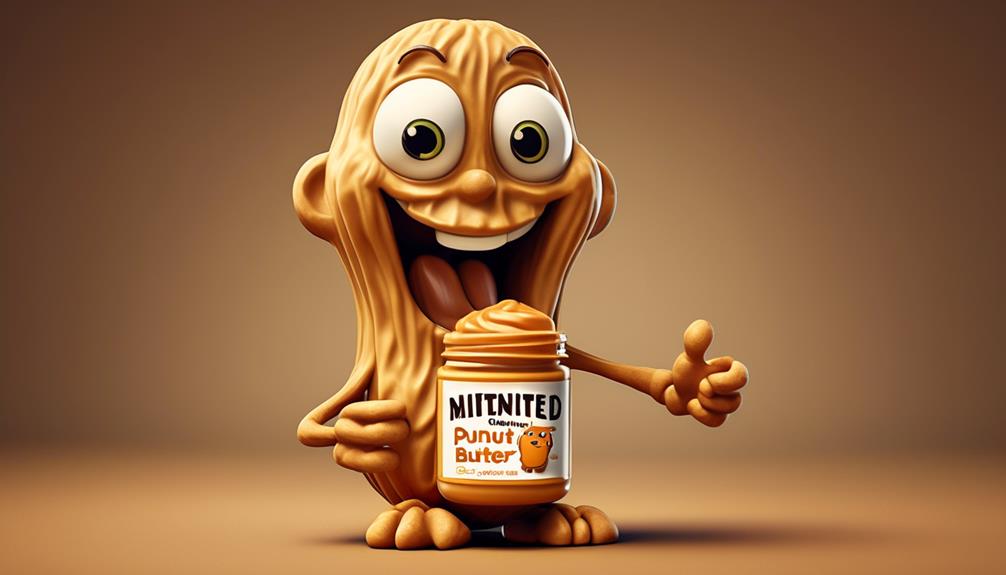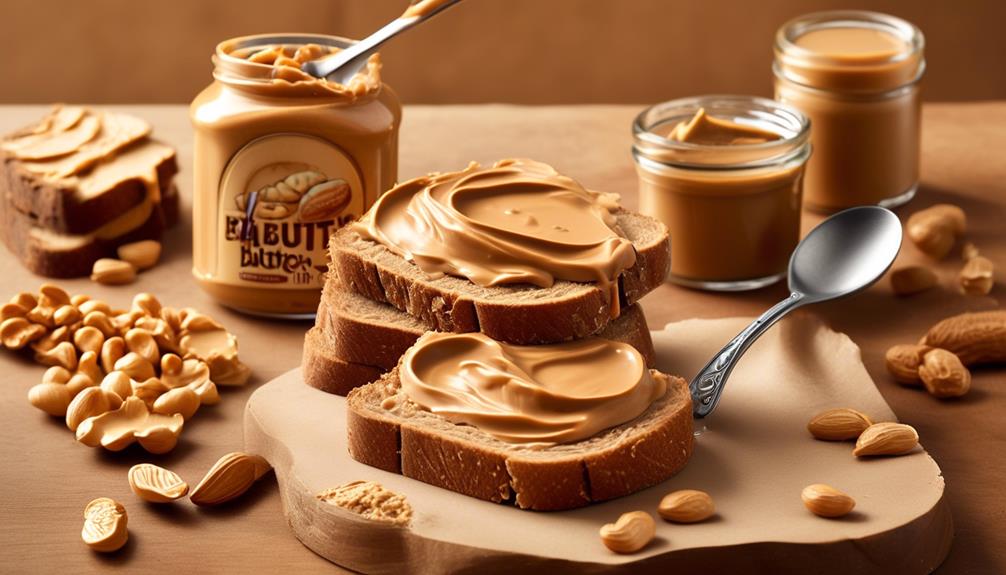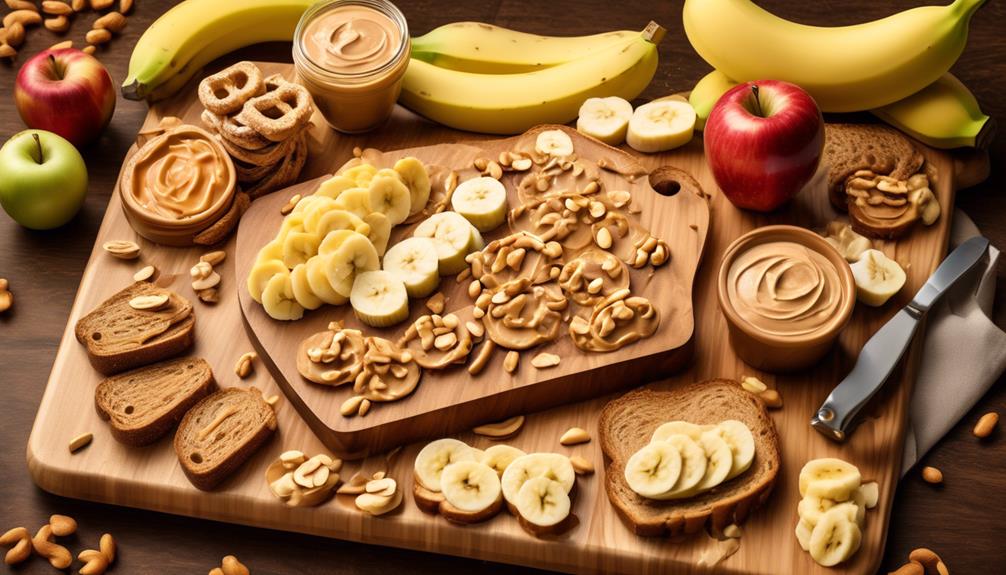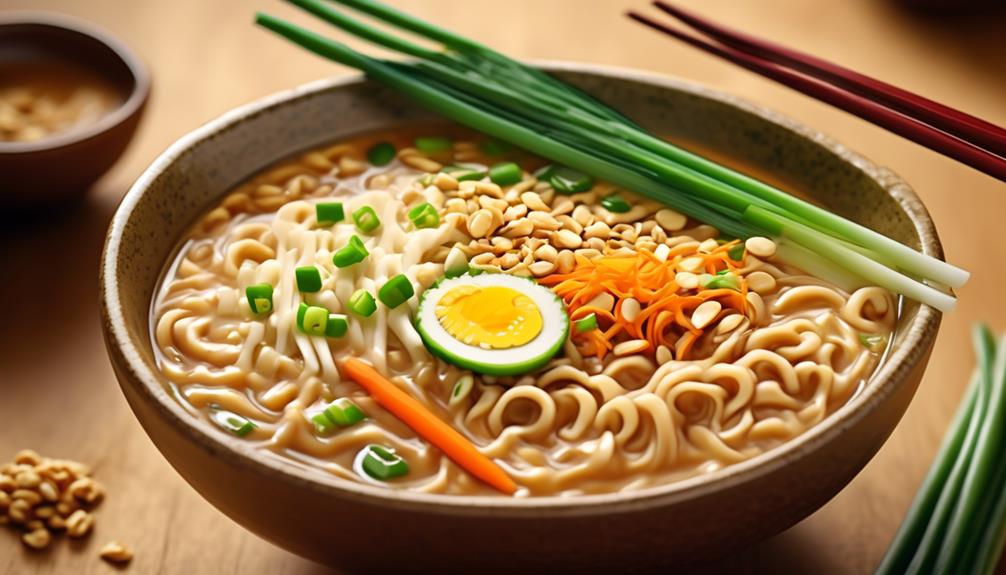We were gathered around the table, exchanging the jar of peanut butter, when someone brought up the amusing term ‘goober butter.’ This sparked laughter among us, prompting me to wonder – what other fun, quirky names exist for this beloved spread?
The world of peanut butter nicknames is surprisingly vast, and each one adds a delightful twist to the creamy treat. So, what other unconventional and whimsical labels are floating around out there for peanut butter?
Well, let's just say there's more to this topic than meets the eye, and it's worth exploring.
Key Takeaways
- Peanut butter synonyms and nicknames such as "Goober spread" and "Nutty spread" add a playful twist to the spread's name.
- Unconventional peanut butter labels and whimsical handles, such as incorporating funny words or comical illustrations, bring joy and lightheartedness to the product.
- Amusing peanut butter aliases and eccentric terms like "Butter of the Gods" showcase imaginative ways to express love for peanut butter and add humor to discussions.
- Witty nomenclature in peanut butter branding captures the essence of the product, engages enthusiasts, and fosters a sense of camaraderie among peanut butter lovers.
Exploring Peanut Butter Synonyms

In the world of culinary delights, peanut butter has captured the hearts and taste buds of many, but did you know that it goes by several amusing and intriguing synonyms? Some of these synonyms include 'goober spread', 'nut paste', 'legume butter', 'groundnut cream', and 'bean butter'.
Each of these names adds a delightful twist to the creamy peanut butter that we all know and love. The term 'goober spread' brings a playful and lighthearted tone to the beloved peanut butter and jelly sandwich, evoking a sense of nostalgia and comfort.
On the other hand, 'nut paste' and 'legume butter' highlight the rich and wholesome nature of this beloved spread, emphasizing its natural and nutritious qualities. 'Groundnut cream' and 'bean butter' provide a more sophisticated and elegant touch, elevating the status of peanut butter to a gourmet ingredient.
These synonyms not only showcase the versatility of peanut butter but also add a layer of whimsy and charm to the beloved pantry staple.
Quirky Peanut Butter Nicknames

As peanut butter enthusiasts, we can't help but chuckle at the array of quirky nicknames this beloved spread has acquired over the years. From 'PB' to 'goober butter' to 'nut paste,' the playful and amusing monikers for peanut butter never fail to bring a smile to our faces.
Whether it's the silly names or the playful terms, the world of peanut butter is full of delightful and lighthearted epithets that add an extra layer of fun to our favorite snack.
Silly Peanut Butter Names
With playful and humorous monikers like 'nutty spread', 'peanut paste', and 'legume goo', quirky peanut butter names add a delightful twist to the conversation about this beloved spread.
These silly peanut butter names aren't only amusing but also serve as lighthearted alternatives to the traditional term.
Whether it's in casual conversations, playful jokes, or as a way to infuse humor into everyday discussions, these quirky nicknames bring a smile to people's faces.
Embracing these quirky peanut butter nicknames adds a playful and creative element to enjoying and discussing peanut butter. They create a sense of intimacy and fun, making the experience of enjoying this tasty spread all the more enjoyable.
Playful Peanut Butter Terms
Let's explore some delightful and whimsical nicknames for peanut butter that add a playful twist to our love for this creamy spread. Here are a few playful peanut butter terms to consider:
- *Nutter Butter*: This fun and lighthearted nickname adds a touch of whimsy to the classic peanut butter.
- *Peanutty Spread*: A light-hearted and humorous term that brings a smile to your face while reaching for the jar of creamy goodness.
- *Butternut Plop*: This quirky and memorable nickname adds an element of surprise and amusement to your typical peanut butter experience.
These playful peanut butter terms infuse a sense of joy and levity into our favorite spread, making snack time even more enjoyable.
Amusing Peanut Butter Monikers
Exploring the world of amusing peanut butter monikers brings a delightful and whimsical twist to our love for this creamy spread, adding a playful touch to snack time. Here are some quirky and entertaining nicknames for peanut butter that are sure to bring a smile to your face:
| Peanut Butter Moniker | Description |
|---|---|
| Peanutty Pat | A whimsical and playful term for peanut butter. |
| Creamy Crunch | A light-hearted and amusing moniker for peanut butter. |
| Nutty Nosh | A fun and quirky nickname for peanut butter. |
| Butterlicious | An entertaining and catchy word to refer to peanut butter. |
These amusing monikers capture the essence of peanut butter in a fun and lighthearted way, making snack time even more enjoyable.
Hilarious Peanut Butter Monikers

Delighting peanut butter enthusiasts worldwide, a plethora of hilariously creative monikers have emerged to add a playful and amusing touch to this beloved spread. These funny names bring a lighthearted twist to the world of peanut butter, infusing joy into every spoonful. With monikers like 'Nutty Nutter Butter' and 'Laughing Legume Spread,' the simple act of enjoying peanut butter becomes a chuckle-inducing experience.
- Playful Conversations: Hilarious Peanut Butter Monikers are perfect for adding a dash of humor to everyday conversations. Whether it's bantering with friends or engaging in witty exchanges on social media, these names bring laughter to the table.
- Recipe Fun: These whimsical names aren't just for conversation but can also be used to inject humor into recipe titles. From 'Whimsical Walnut Wonder' to 'Comic Crunchy Creation,' the possibilities for playful recipe names are endless.
- Everyday Enjoyment: Incorporating these monikers into our daily lives brings a sense of fun and amusement to the simple act of enjoying peanut butter. It's a delightful reminder to not take life too seriously and find joy in the little things.
Unconventional Peanut Butter Labels

Let's talk about the quirky flavor combinations, comedic packaging designs, and humorous promotional campaigns that set unconventional peanut butter labels apart.
These labels bring a playful twist to the classic spread, offering unexpected flavor profiles and eye-catching designs that make us smile.
From clever puns to out-of-the-box branding, these unconventional labels bring a delightful and light-hearted touch to our beloved peanut butter jars.
Quirky Flavor Combinations
Unleash your taste buds with unconventional peanut butter labels featuring quirky flavor combinations that push the boundaries of traditional spreads.
Imagine the tangy crunch of peanut butter and pickles dancing on your tongue, or the fiery kick of sriracha infused with the nuttiness of peanut butter.
These unconventional combinations offer a rollercoaster ride for your taste buds, from the savory delight of bacon mingling with creamy peanut butter to the surprising fusion of wasabi's heat and nuttiness.
And let's not forget the sweet and nutty blend of maple syrup and peanut butter, perfect for breakfast or dessert.
These quirky flavor combinations redefine the peanut butter experience, inviting you to explore new dimensions of taste and indulge in the unexpected.
Comedic Packaging Designs
Quirky flavor combinations have revolutionized the peanut butter experience. Let's explore the world of comedic packaging designs for unconventional peanut butter labels. These designs are anything but ordinary, featuring whimsical illustrations like acrobatic peanuts, jars donning superhero capes, and even jars with googly eyes and funny faces.
Punny slogans such as 'Spread the laughter, spread the peanut butter' or 'Peanut butter: the nutty companion to your bread adventures' add an extra layer of humor to the packaging. Unconventional peanut butter labels may also incorporate playful characters like a peanut butter-loving unicorn or an adventurous peanut butter astronaut.
These designs not only bring a smile to your face but also add a sense of fun and whimsy to the beloved peanut butter jar, making it an experience to cherish.
Humorous Promotional Campaigns
The world of humorous promotional campaigns for unconventional peanut butter labels is filled with creativity, wit, and a sprinkle of nutty charm.
When it comes to grabbing attention and standing out on the shelves, unconventional peanut butter labels use funny words like 'Silly Spread' or 'Laughable Butter.' These labels also incorporate quirky and comical illustrations, making the product visually appealing and memorable.
Additionally, humorous jokes or puns related to peanut butter are cleverly integrated into the label, creating an enjoyable and entertaining experience for customers.
To add an interactive element, social media contests are organized, encouraging people to come up with the wackiest peanut butter label ideas.
Moreover, partnering with a popular comedian to create humorous videos or commercials infuses a sense of humor into the brand, further engaging the audience.
Whimsical Peanut Butter Handles

Amidst the array of peanut butter options, a touch of whimsy infuses the experience with an enchanting playfulness.
Whimsical Peanut Butter Handles, with their quirky and imaginative names, add a delightful twist to the classic peanut butter. These handles are designed to bring a smile to the faces of peanut butter enthusiasts, incorporating whimsical illustrations or playful packaging that make them stand out on the shelves.
As we browse through the grocery aisles, we can't help but be drawn to these jars that exude joy and lightheartedness. Whether it's a whimsical name or a charming character adorning the label, these handles ignite our imagination and elevate the simple act of spreading peanut butter on toast into a moment of whimsical delight. It's as if each jar holds not just creamy or crunchy peanut butter, but a sprinkle of magic that brightens our day.
These playful handles bring a sense of fun and creativity to our kitchen shelves, turning the mundane task of buying peanut butter into a delightful adventure.
Amusing Peanut Butter Aliases

As we peruse the whimsical peanut butter handles with their enchanting names and playful packaging, our attention is drawn to the amusing aliases that add a touch of humor and creativity to the beloved spread. These amusing peanut butter aliases are more than just names; they evoke a sense of fun and lightheartedness, making the act of spreading peanut butter on a slice of bread or stirring it into a bowl of oatmeal a delightful experience.
- Peanutty Spread: This delightful twist on the classic name for peanut butter adds a touch of humor with a playful twist, making it impossible not to smile while reaching for the jar.
- Nutty Nectar: A whimsical name that highlights the nuttiness of peanut butter in a fun and catchy way, making it sound like a sweet and delectable treat.
- Butter of the Gods: This humorous and grandiose alias playfully elevates the status of peanut butter, turning it into a divine indulgence that brings joy to our taste buds.
These amusing aliases not only add a dash of whimsy to our favorite spread but also remind us to embrace the playful side of life, even in something as simple as enjoying a peanut butter and jelly sandwich.
Eccentric Peanut Butter Terms

With a delightful blend of wit and whimsy, peanut butter enthusiasts have coined a delightful array of eccentric terms to playfully describe this beloved spread. These playful expressions add a touch of humor and creativity to the world of peanut butter, making discussions about this popular spread even more enjoyable. From 'creamy goodness' to 'nutty nectar,' these terms showcase the imaginative ways in which people express their love for peanut butter.
Embracing these eccentric peanut butter terms can infuse conversations with a sense of lightheartedness and amusement, creating memorable and engaging exchanges. Whether it's 'spreadable joy' or 'goober gold,' these terms bring a smile to our faces and a chuckle to our conversations. The clever wordplay and puns associated with these terms add an extra layer of fun to the already delightful topic of peanut butter.
Witty Peanut Butter Nomenclature

In the lexicon of peanut butter aficionados, a plethora of witty and inventive nomenclature has emerged to humorously capture the essence of this beloved spread. Embracing this playful approach to naming peanut butter adds a delightful layer of humor and creativity to conversations about everyone's favorite spread. It's a lighthearted and entertaining way to engage with peanut butter enthusiasts, bringing a smile to people's faces and making discussions about peanut butter more enjoyable.
Using witty peanut butter nomenclature not only showcases our love for this delicious spread but also adds a touch of clever amusement to our daily interactions.
- Expressive Creativity: Witty peanut butter nomenclature allows us to express our love for peanut butter in a fun and creative way, infusing humor into our conversations.
- Community Bonding: It serves as a unifying factor, creating a sense of camaraderie and shared enjoyment among peanut butter enthusiasts.
- Light-Hearted Fun: Incorporating playful names for peanut butter injects an element of joy and light-heartedness into an otherwise ordinary topic, making it more engaging and memorable.
Frequently Asked Questions
What Else Is Peanut Butter Called?
We've heard some fun and quirky names for peanut butter! Besides the classic moniker, there's 'monkey butter,' 'goober pea spread,' 'nut paste,' 'spreadable nut delight,' and 'creamy nut slather.'
These playful names add a lighthearted touch to our favorite spread. It's always entertaining to discover the various terms people use for peanut butter – it adds a bit of whimsy to our love for this delicious treat!
What Is the Peanut Butter Phrase?
The Peanut Butter Phrase is a lighthearted and playful term that adds a touch of humor to conversations about this popular spread. It brings a smile to those who love a good laugh and can spark joyful interactions when discussing peanut butter-related topics or sharing recipes.
Embracing the Peanut Butter Phrase adds a delightful and amusing flair to conversations, making the discussion about peanut butter even more enjoyable.
What Is Another Way to Say Peanut Butter to My Jelly?
We can playfully refer to peanut butter as 'smooth nut slather' to add a quirky twist to our jelly pairings.
This term brings a lighthearted touch to our favorite jelly sandwiches, making them even more enjoyable.
It's a fun way to mix things up and bring some humor into our snack time.
What Is the Metaphor for Peanut Butter to My Jelly?
We all know the metaphor for peanut butter to jelly. It's like a perfect harmony, where two things just click. It signifies a strong, inseparable bond between two elements that complement each other seamlessly.
This metaphor can be applied to various situations, adding a touch of humor and warmth to the comparison. It's a light-hearted and relatable way to convey the idea of a perfect match or partnership.
Conclusion
In conclusion, the world of peanut butter is filled with a plethora of quirky, hilarious, and eccentric names that add a touch of whimsy to this beloved spread.
From gooey goober butter to whimsical peanut butter handles, the playful and amusing nicknames for peanut butter make it even more enjoyable to indulge in.
So next time you reach for a jar of this delectable treat, remember to embrace the humor and creativity behind its unconventional labels.









